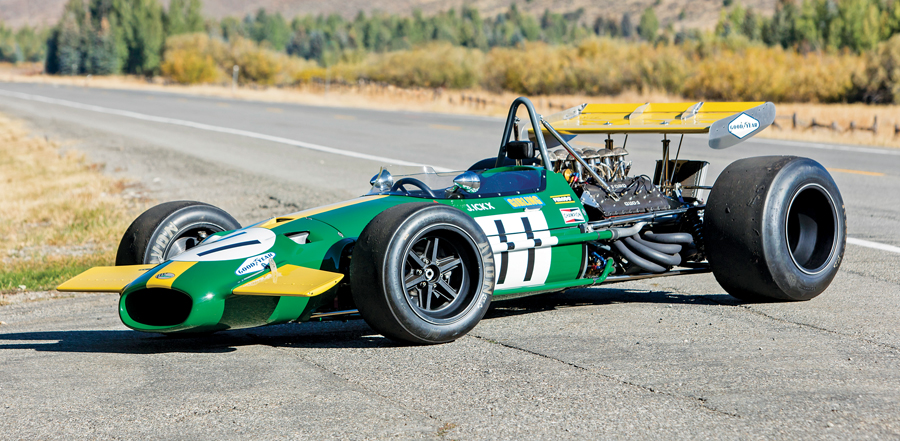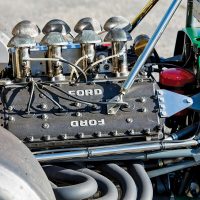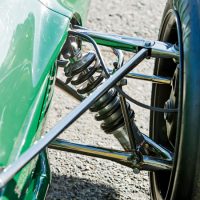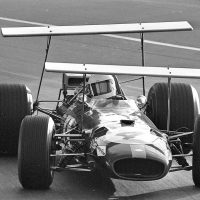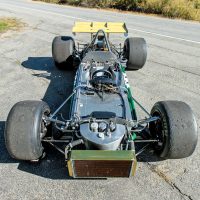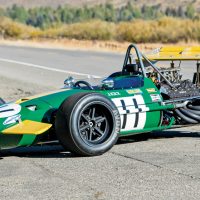It is also the actual car in which Ickx finished 2nd in that same year’s Mexican Grand Prix, 3rd in the French, 5th in the Dutch and 6th in the Spanish round of the 1969 Drivers’ World Championship series.
SCM Analysis
Detailing
| Vehicle: | 1968–69 Repco Brabham-Cosworth BT26/BT26A |
| Years Produced: | 1968 |
| Number Produced: | Four |
| SCM Valuation: | $1,150,000 (this car) |
| Chassis Number Location: | Stamped on frame rail rear |
| Engine Number Location: | Center back of block |
| Club Info: | Masters Historic Formula One USA |
| Website: | http://www.mastershistoricracing.com |
| Alternatives: | 1967 Lotus 49, 1967 BRM P 126, 1969 Ferrari 312B |
| Investment Grade: | B |
This car, Lot 278, sold for $1,105,000, including buyer’s premium, at Bonhams’ Amelia Island, FL, auction on March 7, 2019.
Ironically, Grand Prix cars — long the absolute pinnacle of automotive technological development and world championship drivers’ competition — have for most of the past 40 years been the poor cousin to sports racing cars when it came to collectibility and value.
In the past five or so years, though, Formula One cars — at least a particular subset of them — have moved from being esoteric “weapons grade” purchases to being moderately serious collector assets.
Formula One formulas
Into the early 1970s, Grand Prix was almost a blood sport, with one to five drivers killed in competition every year.
Before roll bars or seat belts, the only perceived way to increase safety was to slow cars down with smaller engines.
From 1961 through 1965 a 1.5-liter limit was imposed, but in the end, it only made the cars smaller and more fragile — not safer. The next change would prove to be genius, and it lasted for roughly 13 years.
Bigger tires and bigger cars
Beginning in 1966, the formula changed to allow 3-liter naturally aspirated or 1.5-liter forced-induction (supercharged or turbocharged) engines.
Doubling the horsepower, weight and size of the drivetrain caused a complete conceptual redesign. Although the classic cigar shape remained, the cars got much larger, suspensions got beefier and deference was given to the awesome new horsepower — and the traction offered by the wide-tire revolution — over aerodynamic subtlety.
The immediate problem was that only Ferrari had a suitable engine — the 250 V12 — and it was heavy. The road-car factory teams such as Ferrari and Maserati that had dominated earlier had been replaced in the 1960s by mostly British builder/racer teams that relied on outside sources for items such as engines and transaxles.
British builders depended on manufacturers such as Coventry Climax and BRM for their engines.
Climax picked the advent of the new rules to exit the business and BRM struggled with an enormously complex and unreliable H-16 concept, so 1966 and ’67 were grim years for most of those teams.
Enter new engines
Driver and team owner Jack Brabham knew of an Australian company named Repco, who had developed an SOHC racing engine based on the aluminum General Motors 215-ci V8.
Although it couldn’t match the horsepower of Ferrari or BRM, the Repco V8 was light, reliable and available. Brabham and Repco won the Constructors’ and Drivers’ Championships in 1966 and 1967.
In mid-1967, the future of Formula One arrived in the form of Lotus’ Type 49, powered by the all-new Cosworth DFV V8 engine.
The Cosworth was light and compact, but it was a scratch-designed racing engine, with four valve heads and far more horsepower. It was exclusive to Lotus for 1967, and when it finished, they won, but reliability and sorting issues gave the championships to Brabham that year.
Ford and Cosworth were in the business of building engines — not running a racing team — so the DFV became available to almost all teams, starting in 1968. For the next 13 years, the Cosworth DFV became the default powerplant for Formula One racing.
The aspirated 3-liter era of Formula One, more or less defined by the DFV engine, is what we now consider to be the golden era of the sport. Most collectors and racers focus their attention on cars from this era.
Our subject car
Our subject Brabham BT26 perfectly represents the transition from the early 3-liter cars to the DFV ones. Intended to continue Brabham’s dominance into 1968, it initially proved sadly inadequate.
It was the last of the Brabham tube-frame cars and predated the idea of wings. The car was designed for the new Repco 4-cam engine — which Lotus and Cosworth completely outclassed. 1968 proved to be a tough year for both Brabham and the BT26, but there was a future.
For the 1969 season, this car was modified to accept the new Cosworth DFV, along with integrated wings and much wider tires.
All of a sudden, it was a serious competitor. Jacky Ickx won the Canadian GP and managed to take 2nd in the 1969 Drivers’ Championship in this car. It is also known as a sweet-driving and forgiving racer.
Race history means a lot
Values for 3-liter F1 cars vary immensely.
You can probably find a weapons-grade Arrows or equivalent for about $400,000, while a world-champion McLaren or Lotus with tons of wins might go for up to $2.5 million.
Established brands carry a clear value over unknowns. A Ferrari, Lotus or McLaren will always be more desirable than an Arrows or Hesketh.
Having at least one GP win can add 20% to 30% to a car’s value. Competitiveness is also very important; most of these cars do get driven, and at least potentially running in front can be worth a serious premium.
Our subject Brabham fits in the lower middle of all of these considerations.
Brabham was a serious team in its day. This car had its requisite GP win and a good history, which counts in its favor.
Competitive aspects are a more difficult call. This is a very early car, and thus will run towards the back of any vintage F1 grid — except Monaco, which has an early F1 class where this would be a front runner.
All in all, this is a very handsome and relatively important early mainstream F1 car from a not-forgotten team. This car is fun and easy to drive but — except at Monaco — will never run near the front of a vintage grid.
My sources all agree that it was well bought and fairly sold. ♦
(Introductory description courtesy of Bonhams.)
